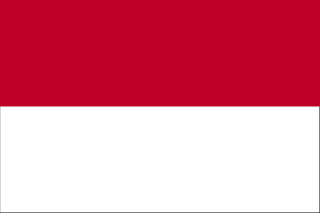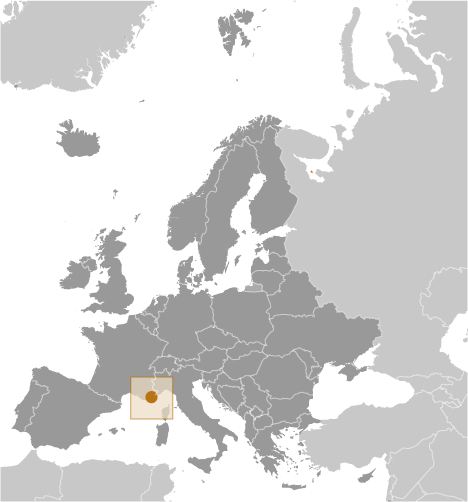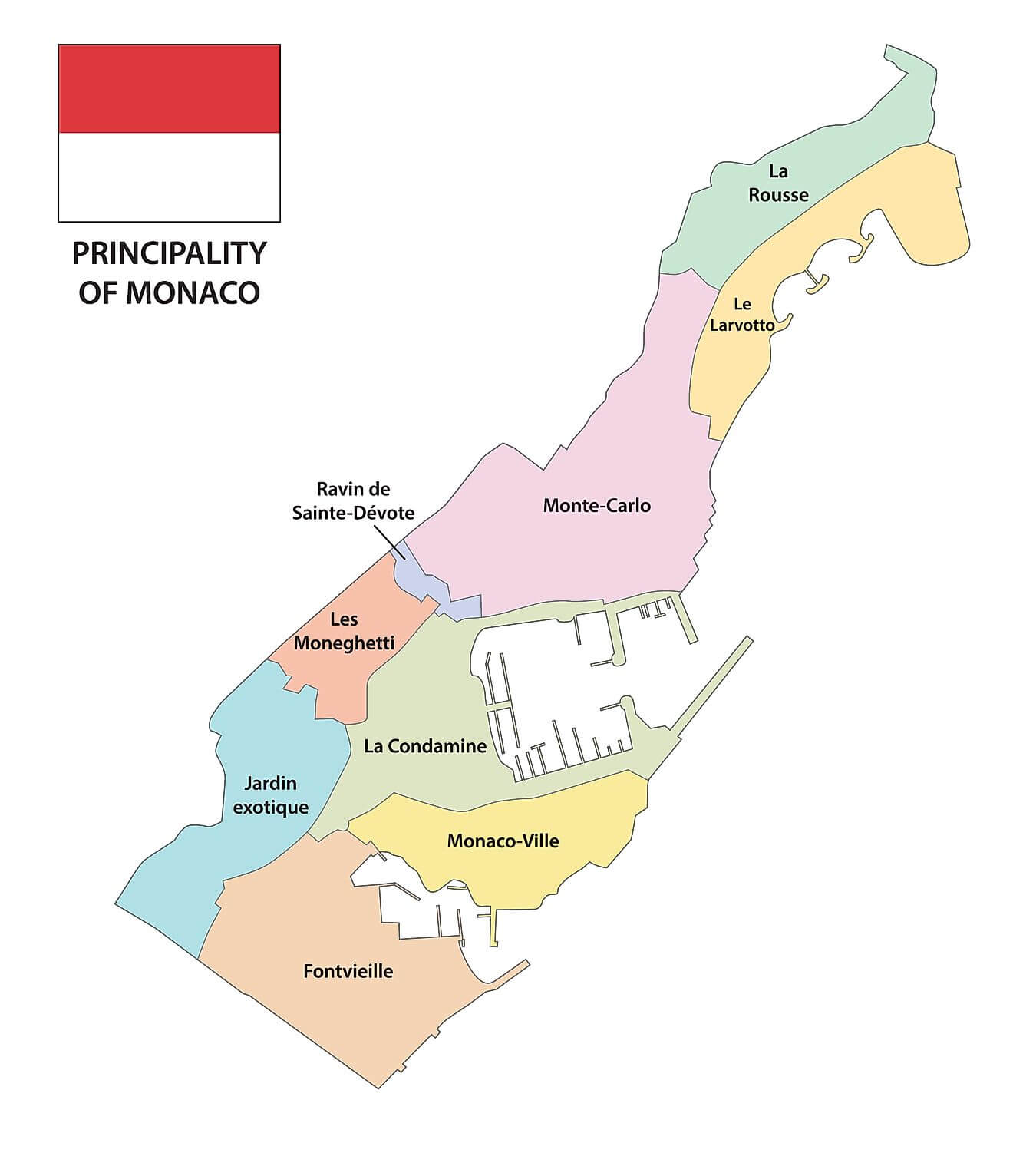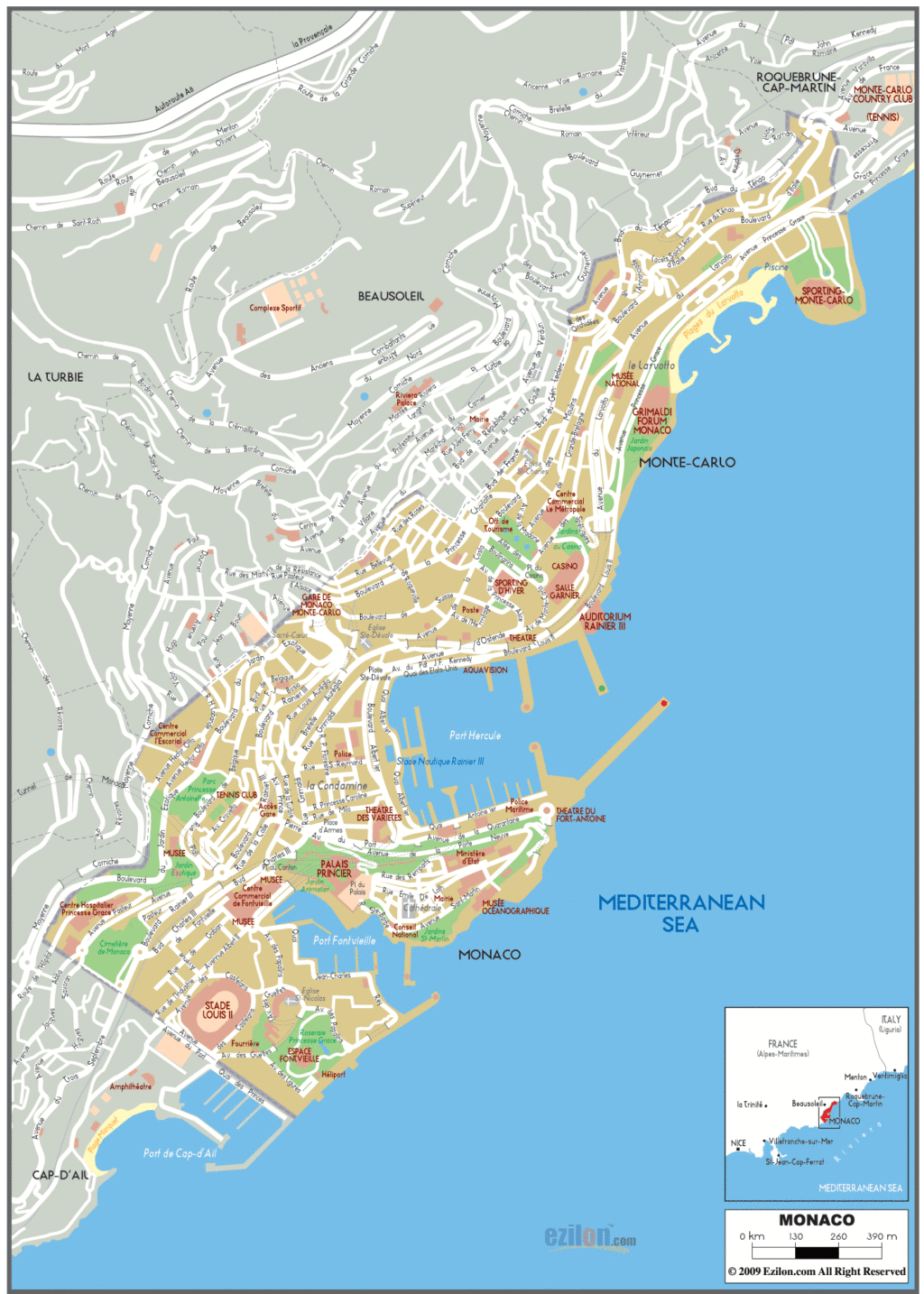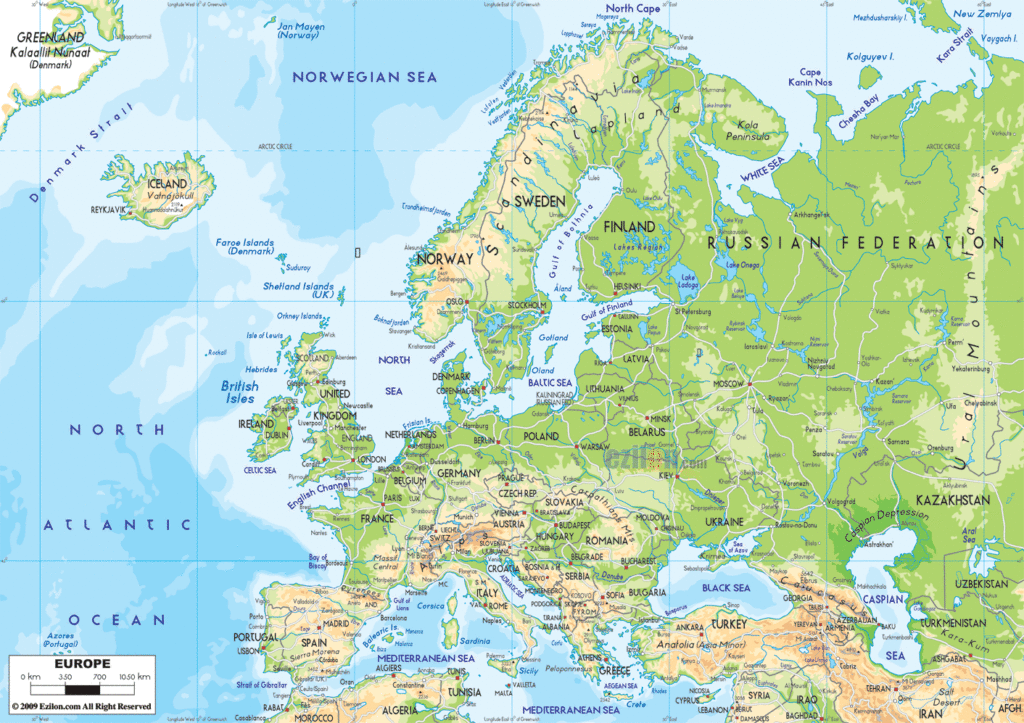As the second-smallest independent state in the world, after the Vatican City, Monaco is a very hilly, rugged and rocky country. The country covers an area of only 2.1 sq. km.
Monaco sits on the Mediterranean Coast, and is almost entirely urban. The highest point is Mont Agel, which rises to 459 ft (140 m). The lowest point is the Mediterranean Sea coast at sea level.
Embark on an exciting journey and discover the beauty of Monaco with its unique map! Monaco is the second-smallest nation in the world, but it is full of surprises. From its picturesque ports to its vibrant buildings and roads, Monaco is a destination worth exploring. With its map, you can get to know Monaco and the regions that make up this small nation. Look out for populated places, ports, buildings, roads, and satellite imagery and get a better understanding of this beautiful country. Get to know Monaco and its regions today with its amazing map!
Location Maps
Where is Monaco?
Monaco is a microstate situated between France and the Mediterranean Sea. It is the second smallest sovereign state in the world, with a total area of only 2.02 square kilometers (0.78 sq mi). This tiny country is renowned for its wealth and luxurious lifestyle, making it one of the most expensive places in the world.
With a population of approximately 38,300 people, French is the official language of Monaco. However, English and Italian are also widely spoken in the country.
High Definition Political Map of Monaco
History
Monaco’s name comes from the nearby 6th-century BC Phocaean Greek colony. Referred to by the Ligurians as Monoikos, from the Greek “μόνοικος”, “single house”, from “μόνος” (monos) “alone, single” + “οἶκος” (oikos) “house”. According to an ancient myth, Hercules passed through the Monaco area and turned away the previous gods. As a result, a temple was constructed there. Because this “House” of Hercules was the only temple in the area, the city was called Monoikos. It ended up in the hands of the Holy Roman Empire, which gave it to the Genoese.
An ousted branch of a Genoese family, the Grimaldi, contested it for a hundred years before actually gaining control. Though the Republic of Genoa would last until the 19th century, they allowed the Grimaldi family to keep Monaco, and, likewise, both France and Spain left it alone for hundreds of years. France did not annex it until the French Revolution, but after the defeat of Napoleon it was put under the care of the Kingdom of Sardinia.
In the 19th century, when Sardinia became a part of Italy, the region came under French influence but France allowed it to remain independent. Like France, Monaco was overrun by the Axis powers during the Second World War and for a short time was administered by Italy, then the Third Reich, before finally being liberated. Although the occupation lasted for just a short time, it resulted in the deportation of the Jewish population and execution of several resistance members from Monaco. Since then Monaco has been independent. It has taken some steps towards integration with the European Union.
Arrival of the Grimaldi family
Following a grant of land from Emperor Henry VI in 1191, Monaco was refounded in 1215 as a colony of Genoa. Monaco was first ruled by a member of the House of Grimaldi in 1297, when Francesco Grimaldi, known as “Malizia” (translated from Italian either as “The Malicious One” or “The Cunning One”), and his men captured the fortress protecting the Rock of Monaco while dressed as Franciscan friars – a monaco in Italian – although this is a coincidence as the area was already known by this name.
Francesco was evicted a few years later by the Genoese forces, and the struggle over “the Rock” continued for another century. The Grimaldi family was Genoese and the struggle was something of a family feud. The Genoese engaged in other conflicts, and in the late 1300s Genoa lost Monaco after fighting the Crown of Aragon over Corsica. Aragon eventually became part of a united Spain, and other parts of the land grant came to be integrated piecemeal into other states. Between 1346 and 1355, Monaco annexed the towns of Menton and Roquebrune, increasing its territory by almost ten times.
1400–1800
In 1419, the Grimaldi family purchased Monaco from the Crown of Aragon and became the official and undisputed rulers of “the Rock of Monaco”. In 1612, Honoré II began to style himself “Prince” of Monaco. In the 1630s, he sought French protection against the Spanish forces and, in 1642, was received at the court of Louis XIII as a “duc et pair étranger”.
The princes of Monaco thus became vassals of the French kings while at the same time remaining sovereign princes. Though successive princes and their families spent most of their lives in Paris, and intermarried with French and Italian nobilities, the House of Grimaldi is Italian. The principality continued its existence as a protectorate of France until the French Revolution.
19th century
In 1793, Revolutionary forces captured Monaco and until 1814 it was occupied by the French (in this period much of Europe had been overrun by the French armies under the command of Napoleon Bonaparte). The principality was reestablished in 1814 under the Grimaldis, only to be designated a protectorate of the Kingdom of Sardinia by the Congress of Vienna in 1815. Monaco remained in this position until 1860 when, by the Treaty of Turin, the Sardinian forces pulled out of the principality; the surrounding County of Nice (as well as Savoy) was ceded to France. Monaco became a French protectorate once again.
Before this time there was unrest in Menton and Roquebrune, where the townspeople had become weary of heavy taxation by the Grimaldi family. They declared their independence, hoping for annexation by Sardinia. France protested. The unrest continued until Charles III of Monaco gave up his claim to the two mainland towns (some 95% of the principality at the time) that had been ruled by the Grimaldi family for over 500 years.
These were ceded to France in return for 4,100,000 francs. The transfer and Monaco’s sovereignty were recognised by the Franco-Monégasque Treaty of 1861. In 1869, the principality stopped collecting income tax from its residents—an indulgence the Grimaldi family could afford to entertain thanks solely to the extraordinary success of the casino. This made Monaco not only a playground for the rich, but a favoured place for them to live.
20th century
Until the Monégasque Revolution of 1910 forced the adoption of the 1911 Constitution of Monaco, the princes of Monaco were absolute rulers. The new constitution slightly reduced the autocratic rule of the Grimaldi family and Prince Albert I soon suspended it during the First World War.
In July 1918, a new Franco-Monégasque Treaty was signed, providing for limited French protection over Monaco. The treaty, endorsed in 1919 by the Treaty of Versailles, established that Monégasque international policy would be aligned with French political, military and economic interests. It also resolved the Monaco succession crisis.
In 1943, the Italian Army invaded and occupied Monaco, forming a fascist administration. In September 1943, after Mussolini’s fall from power, the German Wehrmacht occupied Italy and Monaco, and the Nazi deportation of the Jewish population began. René Blum, the prominent French Jew who founded the Ballet de l’Opéra in Monte Carlo, was arrested in his Paris home and held in the Drancy deportation camp outside the French capital before being transported to Auschwitz, where he was later murdered. Blum’s colleague Raoul Gunsbourg, the director of the Opéra de Monte-Carlo, helped by the French Resistance, escaped arrest and fled to Switzerland. In August 1944, the Germans executed René Borghini, Joseph-Henri Lajoux and Esther Poggio, who were Resistance leaders.
Rainier III, succeeded to the throne on the death of his grandfather, Prince Louis II, in 1949, and then ruled until 2005. On 19 April 1956, Prince Rainier married the American actress Grace Kelly, an event that was widely televised and covered in the popular press, focusing the world’s attention on the tiny principality.
A 1962 amendment to the constitution abolished capital punishment, provided for women’s suffrage and established a Supreme Court of Monaco to guarantee fundamental liberties. In 1963, a crisis developed when Charles de Gaulle blockaded Monaco, angered by its status as a tax haven for wealthy French citizens. The 2014 film Grace of Monaco is loosely based on this crisis.
In 1993, the Principality of Monaco became a member of the United Nations, with full voting rights.
21st century
In 2002, a new treaty between France and Monaco specified that, should there be no heirs to carry on the Grimaldi dynasty, the principality would still remain an independent nation rather than revert to France. Monaco’s military defense is still the responsibility of France.
On 31 March 2005, Rainier III, who was too ill to exercise his duties, relinquished them to his only son and heir, Albert. He died six days later, after a reign of 56 years, with his son succeeding him as Albert II, Sovereign Prince of Monaco. Following a period of official mourning, Prince Albert II formally assumed the princely crown on 12 July 2005, in a celebration that began with a solemn Mass at Saint Nicholas Cathedral, where his father had been buried three months earlier. His accession to the Monégasque throne was a two-step event with a further ceremony, drawing heads of state for an elaborate reception, held on 18 November 2005, at the historic Prince’s Palace in Monaco-Ville. On 27 August 2015, Albert II apologised for Monaco’s role during World War II in facilitating the deportation of a total of 90 Jews and resistance fighters, of whom only nine survived. “We committed the irreparable in handing over to the neighbouring authorities women, men and a child who had taken refuge with us to escape the persecutions they had suffered in France,” Albert said at a ceremony in which a monument to the victims was unveiled at the Monaco cemetery. “In distress, they came specifically to take shelter with us, thinking they would find neutrality.”
In 2015, Monaco unanimously approved a modest land reclamation expansion intended primarily to accommodate desperately needed housing and a small green/park area. Monaco had previously considered an expansion in 2008, but had called it off. The plan is for about six hectares (15 acres) of apartment buildings, parks, shops and offices to a land value of about 1 billion euros. The development will be adjacent to the Larvotto district and also will include a small marina. There were four main proposals, and the final mix of use will be finalised as the development progresses. The name for the new district is Anse du Portier.
On 29 February 2020, Monaco announced its first case of COVID-19, a man who was admitted to the Princess Grace Hospital Centre then transferred to Nice University Hospital in France.
On 3 September 2020, the first Monégasque satellite, OSM-1 CICERO, was launched into space from French Guiana aboard a Vega rocket. The satellite was built in Monaco by Orbital Solutions Monaco.
Physical Map of Monaco

